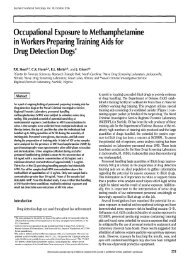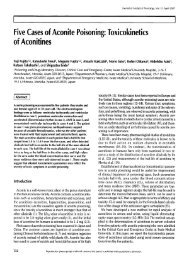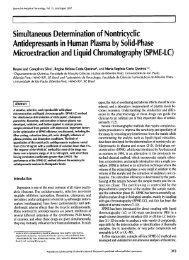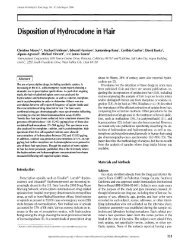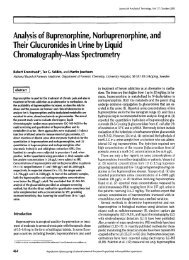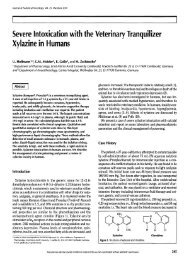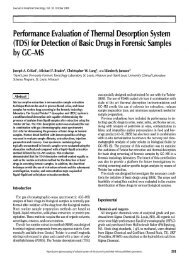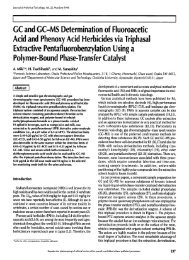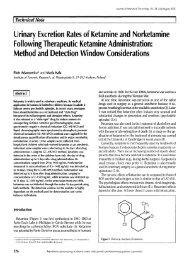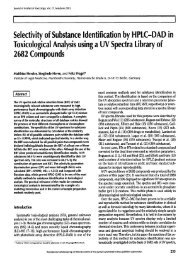Nitrite Adulteration of Workplace Urine Drug-Testing Specimens I ...
Nitrite Adulteration of Workplace Urine Drug-Testing Specimens I ...
Nitrite Adulteration of Workplace Urine Drug-Testing Specimens I ...
You also want an ePaper? Increase the reach of your titles
YUMPU automatically turns print PDFs into web optimized ePapers that Google loves.
Jourr, al <strong>of</strong> Analytical Toxicology, Vol. 22, March/April 1998<br />
Metronidazole was <strong>of</strong> interest because it can be given in doses as<br />
high as 4 g/day. Of the two patients on metronidazole, one was<br />
receiving 1.5 g/day, which produced 0.8 IJg/mL nitrite. Ranitidine<br />
resulted in a similar level <strong>of</strong> nitrite in the urine. The urinary tract<br />
analgesic phenazopyridine was included. Although not con-<br />
taining a nitro group, it was tested because the Chemstrip<br />
package insert indicated that it might give a false-positive<br />
reading for nitrite because <strong>of</strong> the orange-red color it imparts to<br />
the urine (15). The modestly increased apparent nitrite con-<br />
centration with phenazopyridine listed in Table II may be due to<br />
color from phenazopyridine. <strong>Specimens</strong> from patients taking<br />
antifungal and antineoplastic drugs were not tested. The anti-<br />
fungal drugs are applied topically, and relatively little would<br />
reach the urine. With antineoplastic agents, the daily dosage<br />
does not exceed 300 mg <strong>of</strong> parent drug, and it would not increase<br />
urinary nitrite beyond a few nanograms per milliliter.<br />
Medical care: Medications which stimulate the in vivo for-<br />
mation <strong>of</strong> nitrite~nitrate through induction <strong>of</strong> NOS.<br />
]ndomethacin transfusion for premature infants lead to a 25-<br />
fold increase in urine nitrite concentration through a currently<br />
unknown mechanism (26). The increase returned to baseline<br />
after 3 days, indicating that this was a transitory effect not<br />
related to chronic administration. In order to assess the possible<br />
effect <strong>of</strong> indomethacin in a workplace setting, two male subjecL~<br />
<strong>of</strong> working age were given a standard dose <strong>of</strong> indomethacin<br />
(25 rng three times per day) with specimens taken at 2, 8, 12, 24,<br />
and 48 h after the initial dose. All specimens from both subjects<br />
had a nitrite concentration below the limit <strong>of</strong> detection <strong>of</strong> the<br />
method, 0.6 lJg/mL. No effect was observed.<br />
lnterleukin-2 in cancer treatment can increase urinary<br />
Table III. <strong>Nitrite</strong> Concentrations in <strong>Urine</strong> <strong>Specimens</strong> Received for<br />
Employment <strong>Drug</strong> <strong>Testing</strong> which Appeared to Have Been Adulterated<br />
With Excess <strong>Nitrite</strong><br />
Specimen No. <strong>Nitrite</strong> (pg/mL) Specimen No. <strong>Nitrite</strong> (pg/mL)<br />
A* 3640 + 17 5490<br />
1 1910 18 6300<br />
2 4400 19 4200<br />
3 7390 20 7030<br />
4 10,700 21 4140<br />
5 6770 22 4530<br />
6 4400 23 2500<br />
7 11,500 24 11,600<br />
8 5420 25 7780<br />
9 12,200 26 6730<br />
10 8340 27 7750<br />
11 6930 28 4040<br />
12 4630 29 4990<br />
13 3810 30 4140<br />
14 3740 31 6540<br />
15 4070 32 2920<br />
16 4560<br />
Average 59 I0<br />
Range 1910-12,200<br />
* Certified drug-negative urir+e i)(x)l, negative by lest strip for nitrite, fotlified with one vial <strong>of</strong> Klear in 50 mL urine.<br />
r Results rounded to three significant figures because <strong>of</strong> 1000+f(~kl dilution <strong>of</strong> specimet~s.<br />
nitrate and nitrite through the induction <strong>of</strong> cytokines and<br />
NOS (27). This study produced a peak urine nitrate concen-<br />
tration <strong>of</strong> 183 tJg/mL.<br />
Intentional addition to the urine after voiding<br />
"Fable III lists the concentrations <strong>of</strong> nitrite found in ~outine<br />
workplace drug-testing specimens which presented to the labo-<br />
ratory with a pattern consistent with adulteration: an initial<br />
test positive (for cannabinoids), a failure to confirm by GC-MS<br />
due to little or no recovery <strong>of</strong> the ions <strong>of</strong> 9-THCA and its deuter-<br />
ated internal standard, and a strongly positive reaction for nitrite<br />
on the Chemstrip. A clinical specimen being screened for a uri-<br />
nary tract infection produces a light pink color on the Chem-<br />
strip. A specimen to which Klear has been added (or crystalline<br />
potassium nitrite for experimental purposes) produces a vivid<br />
red-violet color that persists for approximately 20 s and then<br />
fades to a pale orange. Each microtube <strong>of</strong> Klear contains about<br />
500 mg <strong>of</strong> potassium nitrite. With a minimal acceptable urine<br />
volume <strong>of</strong> 30 mL, an estimated maximum volume <strong>of</strong> 120 mL (as<br />
may occur in a split specimen collection using a collection con-<br />
tainer), a variable percent purity <strong>of</strong> potassium nitrite (85-96%+),<br />
and the potential for addition <strong>of</strong> either one or two microtubes <strong>of</strong><br />
Klear, a urine specimen to which Klear was added would be<br />
expected to contain between 1900 and 15,000 IJg/mL nitrite.<br />
The 32 specimens suspected <strong>of</strong> nitrite adulteration ranged from<br />
a low <strong>of</strong> 1910 to a high <strong>of</strong> 12,200 1Jg/mL with an average <strong>of</strong><br />
5910. None <strong>of</strong> the 32 specimens had a concentration less than<br />
1500 IJg/mL. Specimen A was prepared in the laboratory by<br />
adding one microtube <strong>of</strong> Klear to 50 mL <strong>of</strong> certified drug-free<br />
urine that was negative for nitrite with the Chemstrip. It pro-<br />
duced a nitrite concentration <strong>of</strong> 3640 IJg/mL.<br />
Background nitrite concentration<br />
in drug-negative specimens<br />
In order to assess background levels <strong>of</strong> nitrite<br />
in urine specimens for workplace drug testing,<br />
specimens which were initial test negative were<br />
evaluated. From among 200 specimens which<br />
were tested by the Chemstrip, 15 were selected<br />
as producing the most color on the Chemstrip<br />
(Note: none <strong>of</strong> the 200 produced the typical<br />
intense pattern <strong>of</strong> nitrite adulteration). These<br />
specimens were stored at room temperature<br />
for 2 weeks, and then tested for nitrite concen-<br />
tration. They were held an additional 6 days<br />
and retested. This process, although uncharac-<br />
teristic <strong>of</strong> holding times and conditions for<br />
employment testing specimens, was used to<br />
represent an extreme circumstance in the<br />
amount <strong>of</strong> background nitrite that might be<br />
found in a negative workplace drug-testing<br />
specimen. The data are displayed in Table IV. On<br />
the first test (2 weeks from collection), the<br />
group averaged 50.2 IJg/mL with a range <strong>of</strong><br />
6.2-128.1. The data on the retest were very<br />
similar. The maximum nitrite concentration<br />
obtained was 129.1 IJg/mL, which was the<br />
highest concentration obtained in the entire<br />
93



